
Gangotri Dham – 2nd Pilgrimage of The Char Dham
The best time to visit Gangotri depends on your preference. Whether seeking spiritual solace or embarking on the Char Dham Yatra each season offers distinct charm.
Gangotri is a pilgrimage destination that beckons travellers with its pristine beauty, spiritual significance, and awe-inspiring landscapes. Choosing the best time to visit Gangotri is crucial to make the most of your experience. Revered as one of the Char Dham pilgrimage sites, Gangotri holds a special place in the hearts of Hindus as it is believed to be the origin of the holy River Ganges.
The best time to visit Gangotri is when the temple opens its doors to devotees during the summer months, usually from May to October, when the weather is more accommodating. Pilgrims embark on the Char Dham Yatra, seeking blessings and purification in the icy waters of the Ganges and immersing themselves in the divine aura of this enchanting region.
The Best Time to Visit Gangotri is:
| Season | Months | Temperature |
|---|---|---|
| Summer | April-June | 15°C to 25°C |
| Monsoon | July-September | 5°c – 16°c |
| Autumn | October-November | 1°c – 8°c |
Here are the details about the Best Time to Visit Gangotri:
Summer Solace (April-June)
- Mild temperatures (15°C to 25°C)
During the summer months of April to June, Gangotri transforms into a haven of sublime beauty. The weather is mild, with temperatures ranging from 15°C to 25°C, making it the perfect time to explore this Himalayan gem. - Snowmelt reveals lush green landscapes
As the snow gracefully yields to the warmth of the sun, it reveals a breathtaking panorama of lush green landscapes, offering a captivating tableau for both pilgrims and nature enthusiasts and yet making it one of the best time to visit Gangotri for those seeking beautiful background for there profile pictures. - Ideal for Char Dham Yatra pilgrimage
The Kapat of Gangotri Dham opens for devotees during the summer season making it the best time to visit Gangotri Temple for those who want to witness the grandeur of the opening ceremony. Summer in Gangotri offers a harmonious blend of spirituality and natural splendour, providing an unforgettable experience for those seeking serenity in the lap of the Himalayas.
Monsoon (July-September)
- Captivating scenery with vibrant flora
During the monsoon season, Gangotri undergoes a captivating transformation, unveiling a mesmerizing scenery adorned with vibrant flora. The heavy rainfall bathes the landscape in a lush green carpet, creating a picturesque backdrop against the majestic Himalayan peaks. The vibrant hues of the blossoming flowers and dense vegetation add a touch of enchantment to the surroundings. - Fewer devotees, providing tranquillity
During the monsoon, Gangotri graces fewer devotees, allowing nature’s symphony to unfold in tranquil splendour thus making it the best time to visit Gangotri for those who seek silence and meditation. - Caution is required due to heavy rainfall and potential landslides – Pilgrims and adventurers need to exercise caution and stay updated on weather forecasts. While the monsoon season brings forth the captivating beauty of Gangotri, it is advisable to plan visits with careful consideration for safety, ensuring a balance between appreciation for nature’s spectacle and the need for precautionary measures.
Autumn (October-November)
- Pleasant weather with clear skies
In the embrace of autumn, Gangotri unfolds its splendour with pleasant weather and clear skies. The temperatures, though starting to dip, create a crisp and invigorating atmosphere making it the best time to visit Gangotri. Whether on a spiritual quest or a nature retreat, autumn in Gangotri offers a perfect blend of mild climate and breathtaking vistas. - Stunning golden hues of autumn foliage
As the leaves gracefully descend, the entire region becomes a symphony of earthy reds, burnt oranges, and vibrant yellows. Against the backdrop of the majestic Himalayas, this seasonal spectacle in Gangotri is truly awe-inspiring. It’s a time when the landscape, adorned in golden splendour, invites contemplation and appreciation for the fleeting yet profound transformations that nature graciously bestows upon Gangotri. - Ideal for spiritual exploration and nature appreciation
This season in Gangotri harmoniously blends spiritual introspection with the awe-inspiring beauty of nature, offering a unique opportunity for both spiritual seekers and those who seek solace in the natural wonders of the Himalayas. The Kapats of the Shrine are closed during this period, Pilgrims partake in this significant moment, bidding farewell to Gangotri with a promise to return in the following pilgrimage season thus making it the best time to visit Gangotri for the pilgrims.
How to reach Gangotri:
By Air:
- The nearest airport is Jolly Grant Airport in Dehradun, approximately 268 kilometres away.
- From the airport, one can hire a taxi or take a bus to reach Gangotri.
By Train:
- The nearest railway station is Rishikesh, around 250 kilometres from Gangotri.
- After reaching Rishikesh, one can hire a taxi or take a bus to proceed towards Gangotri.
By Road:
- Gangotri is well-connected by road to major cities in Uttarakhand.
- One can drive or hire a taxi from Rishikesh or Dehradun.
- Regular bus services are also available from major towns to Gangotri.
Trekking:
- For adventure enthusiasts, trekking to Gangotri is an option.
- The trek typically starts from the town of Uttarkashi and takes around 8-10 days.
Helicopter Services:
- During the Char Dham Yatra season, helicopter services are available from Dehradun to Harshil, and then one can proceed to Gangotri by road.
Places of Attraction near Gangotri:
- Gangotri Temple: The primary attraction, this ancient temple dedicated to Goddess Ganga is a significant pilgrimage site for Hindus.
- Gangotri Glacier: A source of the Ganges River, this glacier is located near Gangotri and is accessible by a trek, providing breathtaking views.
- Surya Kund: A natural hot water spring near the Gangotri Temple is believed to have medicinal properties.
- Gaumukh: A glacier snout and the actual source of the Ganges River, reachable through a challenging trek from Gangotri.
- Bhagirathi Shila: A sacred rock near the Gangotri Temple is believed to be the spot where King Bhagirath meditated to bring the Ganges to Earth.
- Pandava Gufa: An ancient cave with mythological significance is believed to have been used by the Pandavas during their exile.
- Submerged Shivling: A natural rock Shivling submerged in the waters of the Bhagirathi River, visible only during the winter months.
- Kedar Tal: A stunning glacial lake surrounded by snow-capped peaks, accessible through a trek from Gangotri.
- Tapovan: A high-altitude meadow offering panoramic views of the surrounding peaks, accessible via trekking from Gangotri.
- Harsil: A picturesque village en route to Gangotri, known for its apple orchards and serene landscapes.
Gangotri Image Gallery
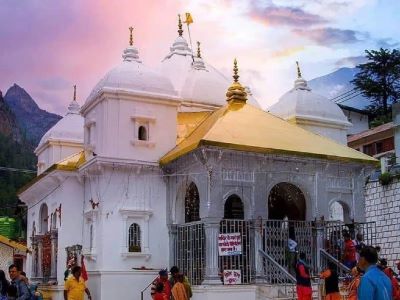
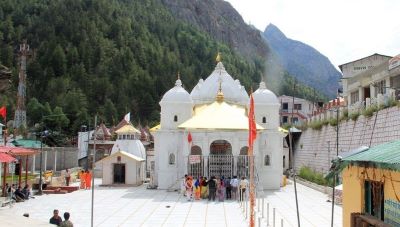
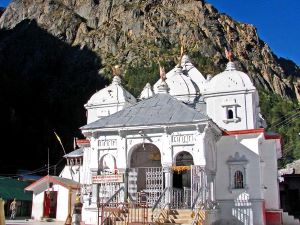
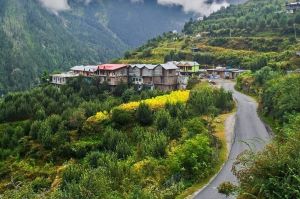
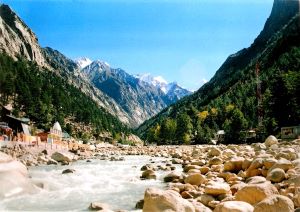
FAQs of the Best Time to Visit Gangotri
1. What is Gangotri known for?
Gangotri is renowned as a sacred pilgrimage site, housing the Gangotri Temple dedicated to Goddess Ganga. It is also a gateway to the source of the Ganges River.
2. When is the best time to visit Gangotri?
The best time to visit Gangotri is during the summer months from May to June when the weather is mild. Autumn (October-November) is also favourable for pleasant weather and clear skies.
3. Is there an entry fee for Gangotri Temple?
No, there is no entry fee for Gangotri Temple. However, donations are welcomed for the temple’s maintenance.
4. What precautions should be taken while visiting Gangotri?
Travellers should be prepared for varying weather conditions, carry essential items, check weather forecasts, and acclimatise properly, especially if trekking or visiting high-altitude areas.
5. What are the cultural festivals celebrated in Gangotri?
Gangotri sees vibrant celebrations during festivals like Diwali, Makar Sankranti, and Ganga Dussehra. These festivals add cultural fervour to the spiritual atmosphere.